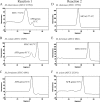Rapid Identification of Mycobacterium tuberculosis and nontuberculous mycobacteria by multiplex, real-time PCR - PubMed (original) (raw)
Comparative Study
. 2009 May;47(5):1497-502.
doi: 10.1128/JCM.01868-08. Epub 2009 Mar 18.
Affiliations
- PMID: 19297596
- PMCID: PMC2681835
- DOI: 10.1128/JCM.01868-08
Comparative Study
Rapid Identification of Mycobacterium tuberculosis and nontuberculous mycobacteria by multiplex, real-time PCR
E T Richardson et al. J Clin Microbiol. 2009 May.
Abstract
The rapid identification of mycobacteria from culture is of primary importance for the administration of empirical antibiotic therapy and for the implementation of public health measures, yet there are few commercially available assays that can easily and accurately identify the mycobacteria in culture in a timely manner. Here we report on the development of a multiplex, real-time PCR assay that can identify 93% of the pathogenic mycobacteria in our laboratory in two parallel reactions. The mycobacteria identified by this assay include the Mycobacterium tuberculosis complex (MTC), the M. avium complex (MAC), the M. chelonae-M. abscessus group (MCAG), the M. fortuitum group (MFG), and M. mucogenicum. The primer targets included the 16S rRNA gene and the internal transcribed spacer. The assay was initially validated with a repository of reference strains and was subsequently tested with 314 clinical cultures identified by the AccuProbe assay or high-performance liquid chromatography. Of the 314 cultures tested, multiplex, real-time PCR produced congruent results for 99.8% of the 1,559 targets evaluated. The sensitivity and the specificity were each 99% or greater for MTC (n = 96), MAC (n = 97), MCAG (n = 68), and M. mucogenicum (n = 9) and 95% and 100%, respectively, for MFG (n = 19). We conclude that this multiplex, real-time PCR assay is a useful diagnostic tool for the rapid and accurate identification of MTC and clinically relevant nontuberculous mycobacteria.
Figures
FIG. 1.
Melting curve analysis of amplicons obtained by multiplex, real-time PCR allows the identification of mycobacteria. Representative reaction 1 melting curves for M. tuberculosis (A), M. avium (B), and M. fortuitum (C) and representative reaction 2 melting curves for M. chelonae (D), M. fortuitum (E), and M. avium (F) are shown. Peaks corresponding to specific products are labeled.
Similar articles
- Rapid and accurate identification of Mycobacterium tuberculosis complex and common non-tuberculous mycobacteria by multiplex real-time PCR targeting different housekeeping genes.
Nasr Esfahani B, Rezaei Yazdi H, Moghim S, Ghasemian Safaei H, Zarkesh Esfahani H. Nasr Esfahani B, et al. Curr Microbiol. 2012 Nov;65(5):493-9. doi: 10.1007/s00284-012-0188-2. Epub 2012 Jul 14. Curr Microbiol. 2012. PMID: 22797866 - Development of multiplex PCR assays based on the 16S-23S rRNA internal transcribed spacer for the detection of clinically relevant nontuberculous mycobacteria.
Ngan GJ, Ng LM, Jureen R, Lin RT, Teo JW. Ngan GJ, et al. Lett Appl Microbiol. 2011 May;52(5):546-54. doi: 10.1111/j.1472-765X.2011.03045.x. Epub 2011 Mar 28. Lett Appl Microbiol. 2011. PMID: 21395629 - Real time PCR for the rapid identification and drug susceptibility of Mycobacteria present in Bronchial washings.
Keerthirathne TP, Magana-Arachchi DN, Madegedara D, Sooriyapathirana SS. Keerthirathne TP, et al. BMC Infect Dis. 2016 Oct 26;16(1):607. doi: 10.1186/s12879-016-1943-y. BMC Infect Dis. 2016. PMID: 27782812 Free PMC article. - Evaluation of the LiPA MYCOBACTERIA assay for identification of mycobacterial species from BACTEC 12B bottles.
Miller N, Infante S, Cleary T. Miller N, et al. J Clin Microbiol. 2000 May;38(5):1915-9. doi: 10.1128/JCM.38.5.1915-1919.2000. J Clin Microbiol. 2000. PMID: 10790121 Free PMC article. - Direct identification of mycobacteria from smear-positive sputum samples using an improved multiplex polymerase chain reaction assay.
Chia JH, Wu TL, Su LH, Kuo AJ, Lai HC. Chia JH, et al. Diagn Microbiol Infect Dis. 2012 Apr;72(4):340-9. doi: 10.1016/j.diagmicrobio.2011.12.008. Epub 2012 Jan 27. Diagn Microbiol Infect Dis. 2012. PMID: 22280996
Cited by
- Application of a new designed high resolution melting analysis for mycobacterial species identification.
Khosravi AD, Meghdadi H, Hashemzadeh M, Alami A, Tabandeh MR. Khosravi AD, et al. BMC Microbiol. 2024 Jun 8;24(1):205. doi: 10.1186/s12866-024-03361-x. BMC Microbiol. 2024. PMID: 38851713 Free PMC article. - Non-Microbiological Mycobacterial Detection Techniques for Quality Control of Biological Products: A Comprehensive Review.
Marius M, Fernandez C. Marius M, et al. Microorganisms. 2024 Apr 12;12(4):788. doi: 10.3390/microorganisms12040788. Microorganisms. 2024. PMID: 38674732 Free PMC article. Review. - Accuracy of QuantiFERON in active tuberculosis suspects with comorbidities and nontuberculous mycobacterial infection in Northern California.
Lu J, Murugesan K, Senchyna F, Budvytiene I, Banaei N. Lu J, et al. J Clin Microbiol. 2023 Nov 21;61(11):e0077523. doi: 10.1128/jcm.00775-23. Epub 2023 Oct 16. J Clin Microbiol. 2023. PMID: 37843251 Free PMC article. - First case of systemic fatal mycobacteriosis caused by Mycobacterium goodii in a pet Kenyan sand boa (Eryx colubrinus loveridgei).
Vetere A, Bertocchi M, Pagano TB, Di Ianni F, Nardini G. Vetere A, et al. BMC Vet Res. 2022 Jul 26;18(1):291. doi: 10.1186/s12917-022-03351-z. BMC Vet Res. 2022. PMID: 35883142 Free PMC article. - SARS-CoV-2 Supply Shortages and Tuberculosis Diagnostics: Current Issues Requiring Immediate Solutions.
Armstrong DT, Tacheny EA, Olinger G, Howard R, Lemmon MM, Dasgupta D, Eisemann E, Parrish N. Armstrong DT, et al. J Clin Microbiol. 2021 Nov 18;59(12):e0077821. doi: 10.1128/JCM.00778-21. Epub 2021 Sep 29. J Clin Microbiol. 2021. PMID: 34586893 Free PMC article.
References
- Barnett, K., and R. Medzon. 2007. Scrofula as a presentation of tuberculosis and HIV. Can. J. Emerg. Med. Care 9176-179. - PubMed
- Beqaj, S. H., R. Flesher, G. R. Walker, and S. A. Smith. 2007. Use of the real-time PCR assay in conjunction with MagNA Pure for the detection of mycobacterial DNA from fixed specimens. Diagn. Mol. Pathol. 16169-173. - PubMed
- Bittner, M. J., E. A. Horowitz, T. J. Safranek, and L. C. Preheim. 1996. Emergence of Mycobacterium kansasii as the leading mycobacterial pathogen isolated over a 20-year period at a midwestern Veterans Affairs hospital. Clin. Infect. Dis. 221109-1110. - PubMed
Publication types
MeSH terms
Substances
LinkOut - more resources
Full Text Sources
Other Literature Sources
Medical
